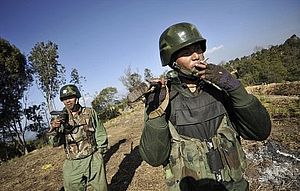This past weekend, the Myanmar government announced that it will sign a permanent cease-fire deal with seven or eight of the ethnic armed insurgencies in the country. This will be a permanent peace deal, not a temporary cease-fire like some of those arranged between the insurgencies and the government in the past. As such, it could provide a measure of stability before the upcoming national elections, and it includes some of the longest-fighting insurgent groups, like the Karen National Union. (Some version of the Karen militia has been battling the central government almost since Myanmar gained independence more than six decades ago.) The deal will potentially end decades of war in some areas of the country, and allow for development and investment in those areas.
The groups that signed onto the permanent peace deal were not a surprise—they had already signed earlier agreements with the government that were frameworks for permanent deals. Government ministers and peace negotiators are cautiously optimistic that the deal will allow for people in some ethnic minority dominated areas to vote more easily, making the November elections more representative of Myanmar’s entire population.
However, the peace deal includes only about half of the ethnic insurgencies who were negotiating with the Thein Sein government, and about a third of the armed insurgencies overall. The government was negotiating with fifteen armed groups; as many as eight signed, and there are at least twenty-one armed groups in the country, if not more, according to Myanmar observers. Most notably, the Kachin Independence Army (KIA), one of the largest and best-armed groups, did not sign the deal. In addition, the United Wa State Army (UWSA), probably the best-armed and largest of the insurgencies—a group allegedly linked to massive narcotics production and shipment—did not sign the agreement. The United Wa State Army has operated its territory, historically home to the Wa people, as essentially an independently functioning state for nearly two decades now.
With the UWSA’s arms and money, it will be very challenging for any government to get them to give up control of their territory. Although the UWSA and many of the groups that did not sign the deal have not had any recent major clashes with the Myanmar army, a future war is not out of the question, and the KIA has had numerous recent battles with the military.
The government, and the peace negotiators, may be hoping that, once the other armed groups see the stability and development that comes to areas like the Karen homeland, the rejectionists may be tempted to sign on as well. This may happen, although it would be too late to help the ruling party. As the Myanmar Times notes, “The presence in Naypyidaw on October 15 of only seven or eight ethnic groups [to sign the deal], with a small minority of combatants between them, is unlikely to give the president and the ruling Union Solidarity and Development Party the boost to their credibility they sought before the November 8 vote.”
In addition, despite the government’s denials that the army intends to target rejectionists, it remains possible that, after the election, the Myanmar military will attack some of the holdout groups, seeking to apply more pressure on them—and potentially precipitating wider conflict. And any conflict that drew in the United Wa State Army, whose leaders reportedly have grown worried about their control of the Wa regions following brutal fighting between the military and Kachin and Kokang rebels, would be disastrous for Myanmar’s nascent political reforms.
Joshua Kurlantzick is a fellow for Southeast Asia at the Council on Foreign Relations. This post appears courtesy of CFR.org.

































